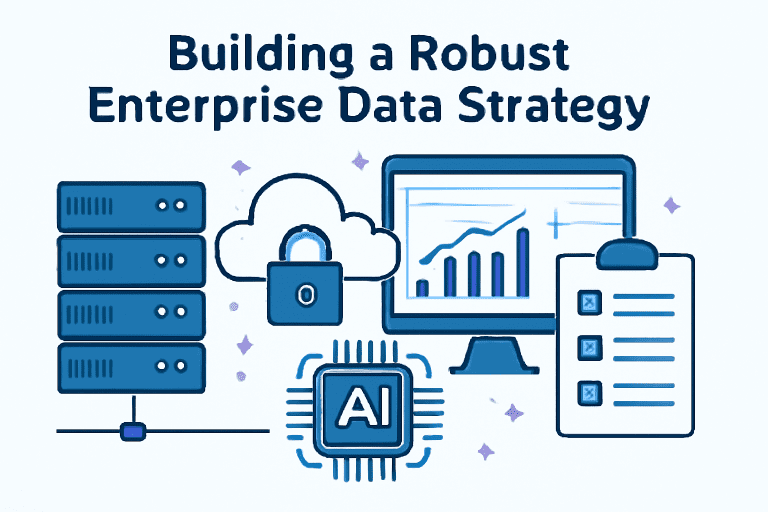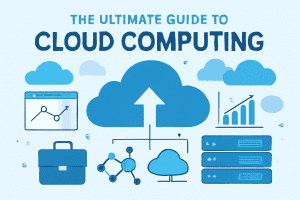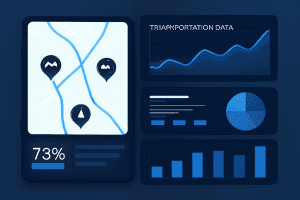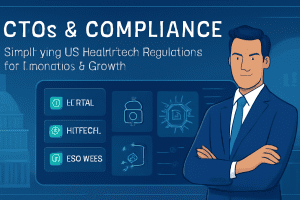Introduction
In today’s data-driven world, a robust enterprise data strategy is essential for organizations seeking to unlock the full potential of their data assets. It provides a comprehensive roadmap for managing, governing, and leveraging data to drive innovation, improve decision-making, ensure compliance, and gain a competitive advantage.
This blog explores the benefits, use cases, key processes, costs, and best practices involved in building an effective enterprise data strategy. For further insights into AI-powered data solutions and digital transformation, visit TechOTD’s AI Services and explore their technology blog.
Benefits of a Robust Enterprise Data Strategy
-
Informed Decision-Making: Having reliable, consistent data reduces errors and enables rapid, strategic business choices across all organizational levels.
-
Improved Operational Efficiency: Streamlining data access and integration eliminates duplication and redundant manual efforts, allowing employees to focus on value-added tasks.
-
Regulatory Compliance & Risk Management: Implementing governance frameworks ensures compliance with critical regulations such as GDPR, HIPAA, and PCI-DSS, minimizing costly penalties and protecting customer privacy.
-
Enhanced Customer Experience: Organizations gain a 360-degree customer view with unified data, enabling personalization, targeted marketing, and superior service.
-
Data Security and Risk Mitigation: Strong data security policies protect sensitive information from unauthorized access and data breaches.
-
Scalability and Future-Readiness: A good data strategy builds scalable infrastructure that adapts easily to growing data and emerging technologies.
-
Cost Savings: Reducing redundant systems and improving data quality lowers overall IT costs and operational expenses.
Use Cases for Enterprise Data Strategy
-
Customer Analytics and Personalization: Tailoring marketing campaigns and services based on unified customer data insights.
-
Fraud Detection and Risk Assessment: Combining real-time data streams across departments for proactive fraud prevention.
-
Predictive Maintenance: Leveraging data to predict failures and reduce downtime in manufacturing and operations.
-
Regulatory Reporting and Audit Readiness: Automated data lineage and governance ensure smooth compliance reporting.
-
Product and Market Innovation: Data-driven R&D accelerates new product development and market adaptation.
The Process of Building an Enterprise Data Strategy
-
Planning and Goal Setting:
Align data strategy objectives with business goals such as reducing churn, speeding time-to-market, or enhancing customer satisfaction. -
Current State Assessment:
Audit existing data systems to identify redundancies, quality issues, and shadow IT. -
Future State Vision:
Define the ideal “trusted, scalable, and compliant” data environment tailored to business needs. -
Roadmap Development:
Develop structured implementation plans prioritizing quick wins and strategic initiatives. -
Implementation:
Deploy governance, data quality, integration, and security processes aligned with roadmap milestones. -
Monitoring and Continuous Improvement:
Track adoption metrics, data quality, and compliance, refining strategy as business evolves.
Cost of Enterprise Data Strategy
The investment varies widely based on scale, complexity, industry regulations, and existing infrastructure. Key cost drivers include:
-
Integration and Migration: Consolidating legacy systems and data silos can consume 40-50% of initial budgets.
-
Technology and Tools: Cloud platforms offer flexible spending models; on-premises solutions require higher upfront costs.
-
Governance and Training: Developing policies, training personnel, and managing compliance are ongoing investments.
-
Talent: Skilled data engineers, scientists, and governance experts are essential and can be a significant expense.
Many organizations allocate between 3-6% of their IT budget to data strategy-related initiatives.
Best Practices
-
Start with High-Value Use Cases: Focus on domains with measurable ROI to build momentum.
-
Invest in Data Lineage Early: Trace and document data origins to boost trust and audit readiness.
-
Integrate Compliance into Pipelines: Address privacy and security during data ingestion, not as an afterthought.
-
Balance Governance with Innovation: Create “innovation zones” for experimental AI or data products without sacrificing control.
-
Prioritize Metadata Management: Catalog and document data thoroughly for easy discovery and security.
-
Measure Adoption, Not Just Implementation: Encourage culture shifts through training, metrics, and leadership incentives.
-
Design for Change: Utilize modular architectures anticipating evolving regulations and technologies.
How TechOTD Supports Enterprise Data Strategy
At TechOTD, we combine AI expertise, cloud infrastructure, and agile methodologies to build tailored enterprise data strategies that enhance operational resilience and unlock growth opportunities. Learn more about our mobile app and AI services.
Conclusion
A robust enterprise data strategy is vital to navigate today’s complex data landscape and drive sustainable business success. By aligning data initiatives with business goals, embedding governance and compliance, and prioritizing scalability and adoption, organizations can unlock significant value from their data assets. Partnering with experts like TechOTD ensures a structured, effective implementation that powers innovation and competitive advantage.
Explore the latest trends and insights in data strategy and AI on the TechOTD Blog.
FAQs
Q1: What is an enterprise data strategy?
A plan that aligns data management, governance, and analytics capabilities with business objectives to maximize data value.
Q2: How does a data strategy improve operational efficiency?
By reducing data silos, duplication, and manual errors, enabling faster, informed decision-making.
Q3: What industries benefit most from enterprise data strategies?
Finance, healthcare, retail, manufacturing, and telecom are leading adopters due to heavy data use and regulation.
Q4: Can AI be integrated with an enterprise data strategy?
Yes, clean, governed data is essential to drive AI and machine learning initiatives effectively.
Q5: How much does an enterprise data strategy cost?
The investment varies, but companies typically allocate 3-6% of their IT budgets toward data strategy initiatives.











